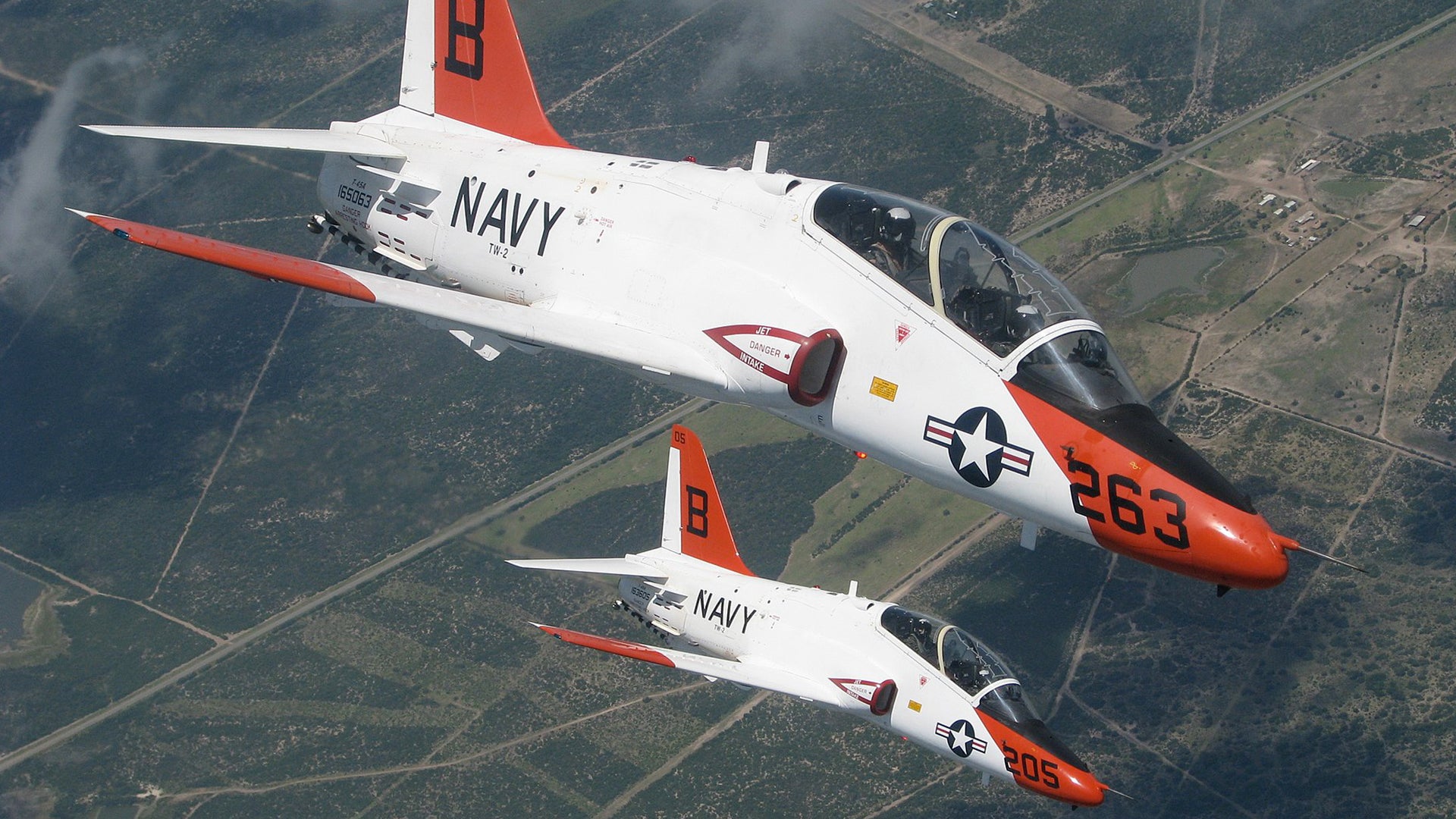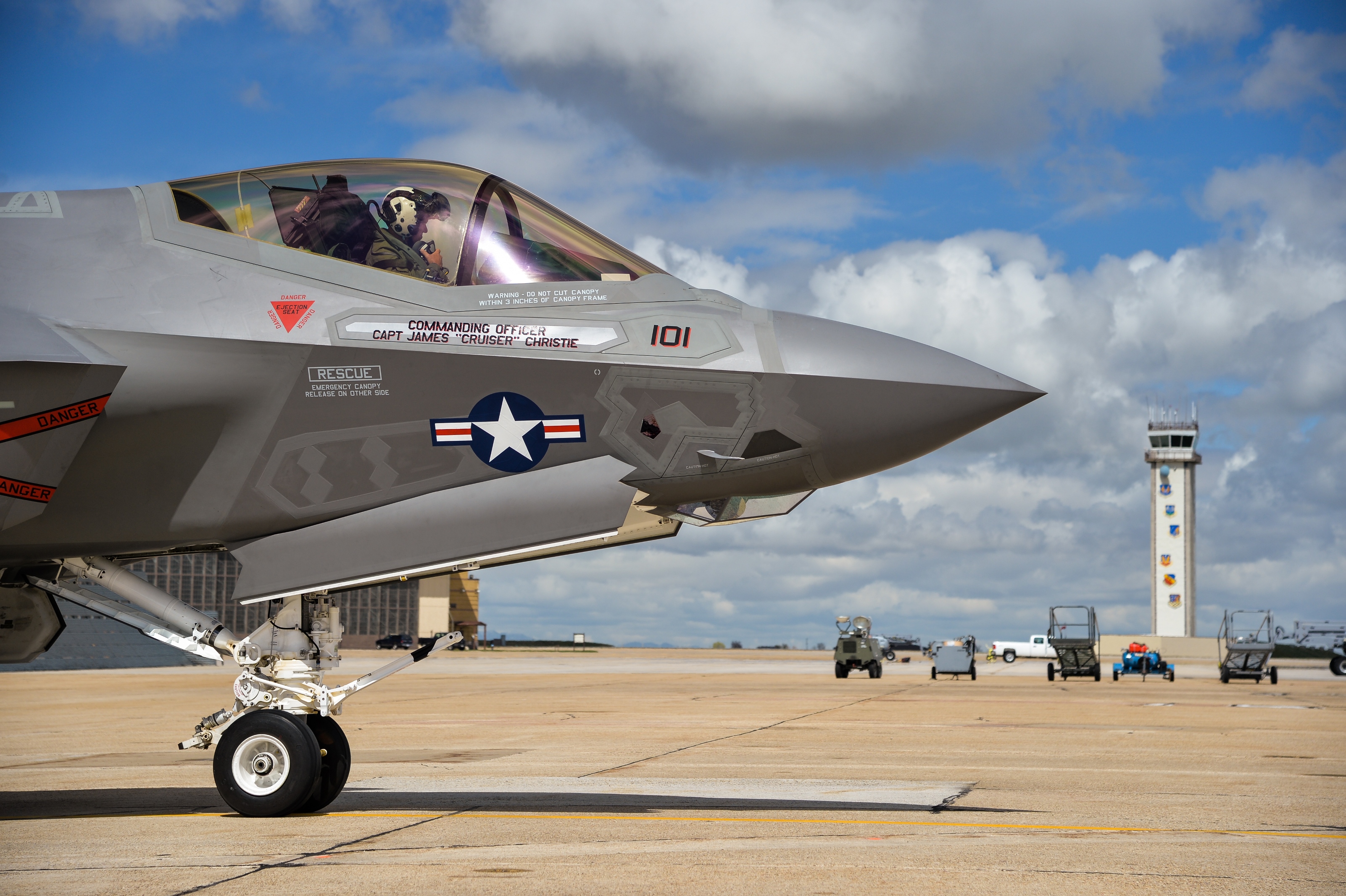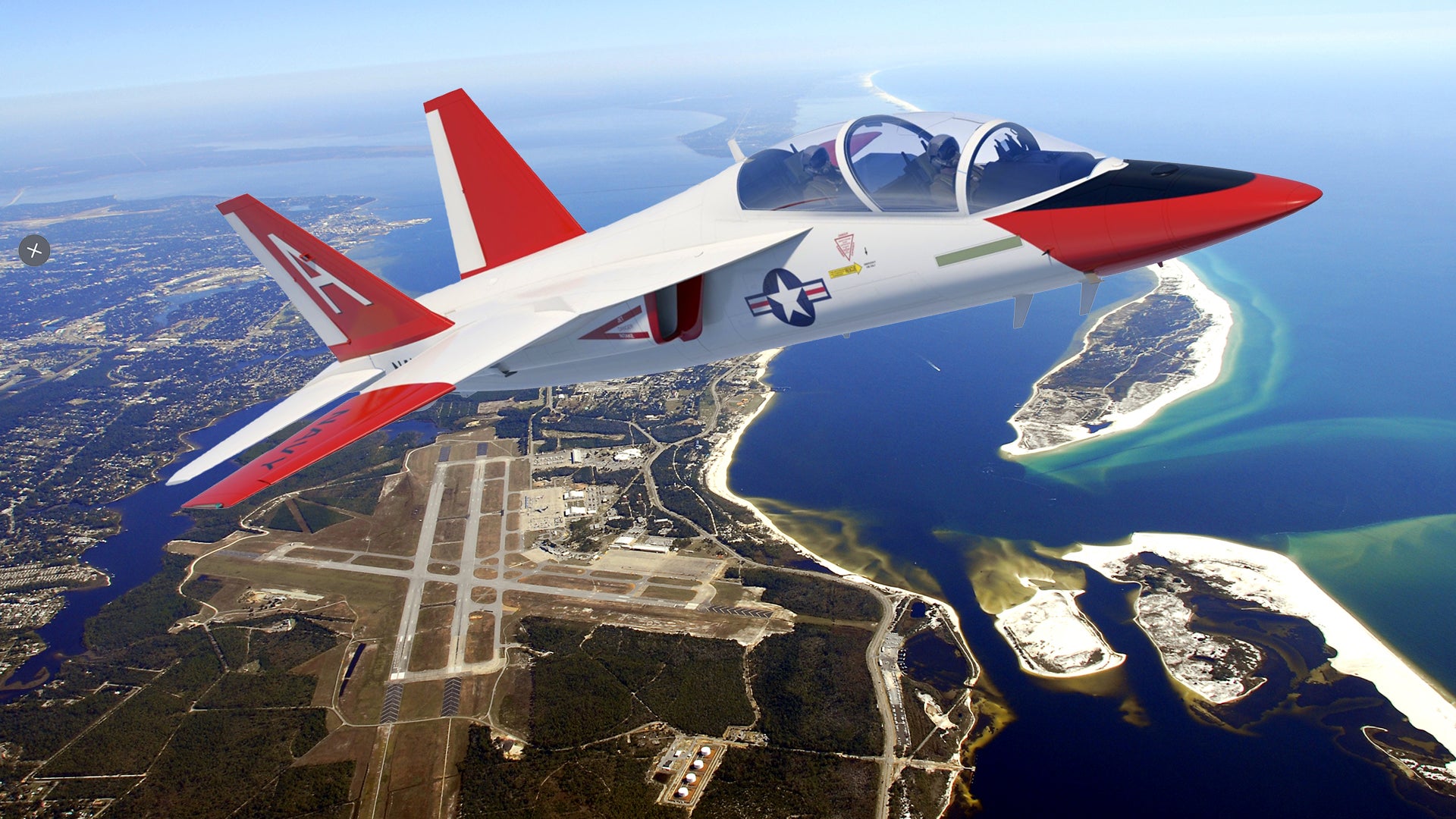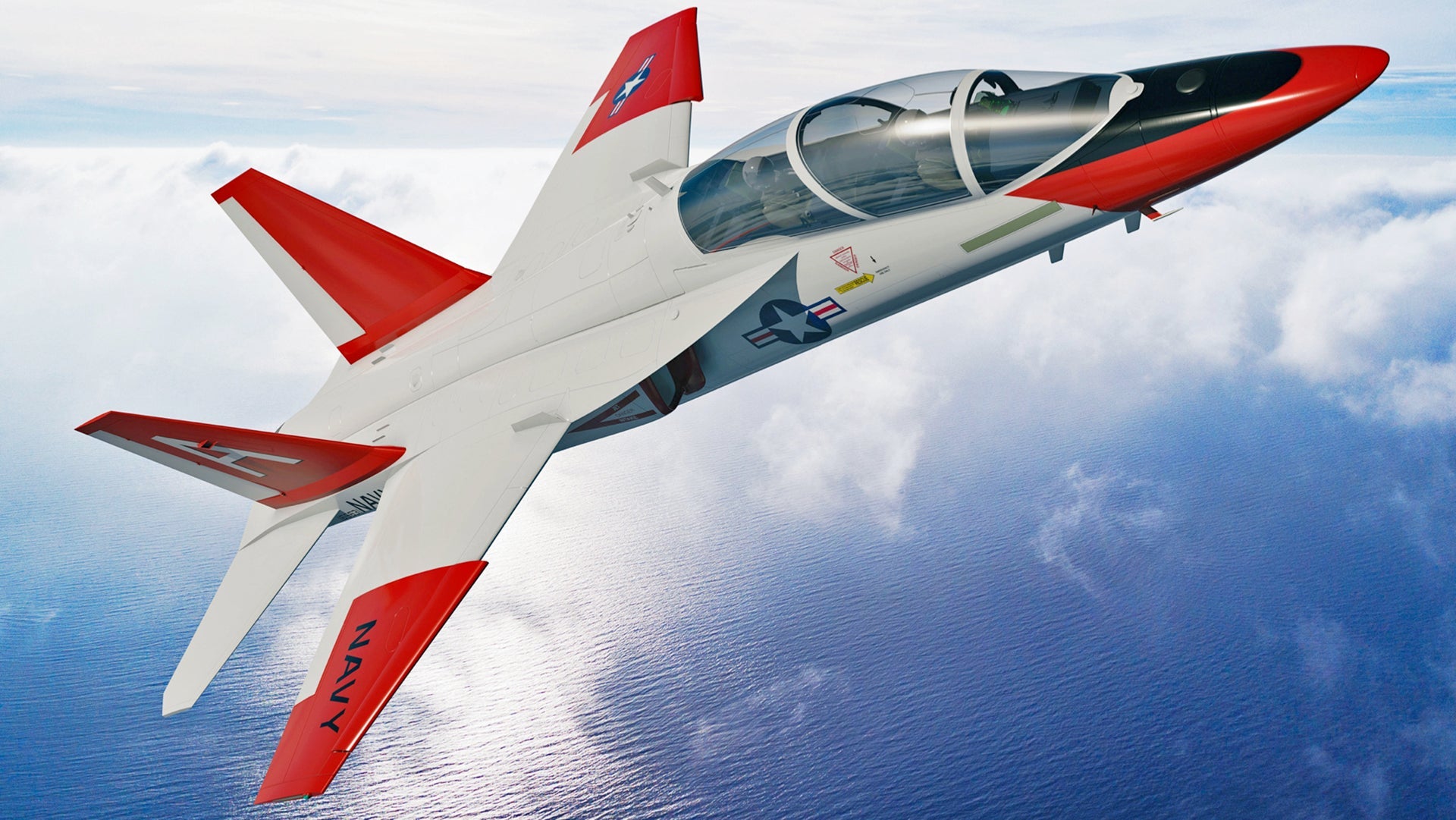Major changes to advanced jet training are currently in vogue within the U.S. Department of Defense, and the latest requirement has now been drafted by the Navy, which is seeking a “Tactical Surrogate Aircraft.” It is described as a two-seat “fighter type” jet that the service will be able to use as a companion trainer and as an adversary. The latest Sources Sought Notice has many parallels with the Navy’s plans to introduce a new Undergraduate Jet Training System (UJTS), which you can read more about here, as well as with the Air Force’s recent Advanced Tactical Trainer proposal, both of which could be considered revolutionary, for better or worse.
The Sources Sought Notice for the Tactical Surrogate Aircraft was published yesterday and involves the Naval Air Warfare Center Aircraft Division (NAWC-AD) Specialized and Proven Aircraft Program Office (PMA-226), which is looking for information from industry. The same notice describes the Tactical Surrogate Aircraft as “a key tool for future fighter pilot training” and states that the Navy is currently examining a potential buy of 64 jets, for which a formal program could potentially be launched in fiscal year 2024 or FY2025.

The Sources Sought Notice is not a guarantee the Navy will actually pursue a Tactical Surrogate Aircraft procurement. Instead, it’s simply a feasibility study that will aim to find out the costs and timelines involved in such a program.
The requirements of the Tactical Surrogate Aircraft are threefold. The first role is as a companion trainer, an aircraft that provides additional flight time and continuation training for naval aviators who have already graduated with their “wings of gold” and have progressed to a frontline Type Model Series (TMS) aircraft. This kind of capability is of increasing relevance for air forces in general, with a need to reduce expensive flight hours on operational types and also preserve precious airframe life on high-end and, increasingly, fifth-generation types, such as the Navy’s F-35C stealth fighter and whatever might come after it. In the past, the Navy has also referred to this requirement as “tactical auxiliary.”

Not surprisingly, the Navy wants the Tactical Surrogate Aircraft to “simulate and/or replicate current and future fighter aircraft systems,” which would be a prerequisite of the companion trainer role, in particular. The aircraft, like the UJTS trainer, is not required to perform catapult launches or arrested landings aboard aircraft carriers, opening the door to various land-based types.
The second requirement is for adversary air support, essentially the same kind of red air threat replication that’s currently provided to the Navy by a mix of in-house aggressor squadrons flying an assortment of jets, as well as by contractors, who provide services to different branches of the military, often in support of specific training events. On the Navy side, efforts are already underway to meet the growing demand for red air, the service adding surplus USAF F-16s for adversary duties in a process you can read more about here.

The kinds of red air work that a trainer-based platform might be expected to perform would not necessarily include dueling with fighters in large-scale exercises, for example, but such an aircraft would be entirely suitable for more basic target duties, including radar intercepts and threat replication for warships.
Last, the Navy envisages its Tactical Surrogate Aircraft serving as “a flight lead aircraft for Fleet Replacement Squadrons.” These squadrons are the operational training units for the Navy’s frontline force and in the tactical community. Their job includes carrier qualifying new pilots for specific aircraft types, as well as other critical tactical aspects of the assigned mission.
The flight lead aircraft is the one flown by the flight leader in a multi-aircraft formation, which suggests that this role envisages a jet that will be used as part of the training process for future fighter pilots within the relevant Fleet Replacement Squadrons.

Perhaps, when serving as a flight lead aircraft, the Tactical Surrogate Aircraft could be equipped with additional training aids to increase the effectiveness of the syllabus being delivered. Other possibilities include using the jet to practice more complex parts of the conversion syllabus before going out and doing the same in a frontline jet, or possibly accompanying pilots as they undergo their first carrier qualifications on the ship itself.
Interestingly, the first two of the stated requirements are already stipulated as part of UJTS, so it’s not entirely clear why the Navy has now decided to look at a discrete Tactical Surrogate Aircraft that would be acquired on top of the selected UJTS trainer, or T-XX, which will directly replace the T-45 Goshawk for the intermediate and advanced portions of the training program for future Navy and Marine fighter pilots.
Today, the T-45 jet trainer is used to train Navy and Marine Corps pilots:

The Sources Sought Notice also brings attention to the various capabilities and attributes that the Navy needs in a potential Tactical Surrogate Aircraft.
These include a two-seat cockpit that can be configured for single-seat while the rear cockpit can be configured for a variety of missions. Performance-wise, a minimum level aircraft speed of at least Mach 0.9 is stipulated at 10,000 feet, with a minimum ceiling of 45,000 feet, and minimum G-force structural limits of at least 7.5G or 6G sustained.
The Navy demands an average sortie duration of at least 90 minutes, including 30 minutes of tactical maneuvering, and provides further details for three particular mission profile subsets: Basic Fighter Maneuvering (BFM), air-to-air, and air-to-ground.
In the cockpit, the Navy wants to provide the pilots with large-area displays and open architecture avionics that can accept additional inputs to replicate frontline aircraft cockpits as well as present simulated displays of aircraft combat systems, simulated inputs, and simulated weapons. In addition to the displays, the hands-on stick and throttle (HOTAS) controls should also be reconfigurable to replicate “multiple” frontline aircraft. The pilot should also be provided with a low-cost helmet-mounted display, again capable of being configured to mimic the displays found on frontline jets.

Specific items of avionics outlined in the list of requirements include Tactical Combat Training System (TCTS) Increment II, Multifunctional Information Distribution System (MIDS), and Red Net, the latter being a tactical and situational awareness datalink system that uses a commercially available tablet-kneeboard display. Red Net has already been installed on Marine Corps F-5N/F aggressor jets, and you can read all about it here.

Various mission kits are envisaged for the Tactical Surrogate Aircraft, with the standard load-out comprising a Captive Air Training Missile (CATM) on one wingtip and one of several different types of Air Combat Maneuvering Instrumentation (ACMI) pods on the other wingtip. Underwing stations should be able to carry fuel tanks, or additional pods, including electronic warfare pods.
As is common for a modern advanced trainer, the Tactical Surrogate Aircraft will need to be able to record flight data and performance information onto a data storage device and/or downloaded in flight, for post-flight analysis.
On top of these must-have features, the Navy also proposes various desired capabilities that could be selected for the Tactical Surrogate Aircraft if feasible. Among them are additional sensors (ECM, infrared search and track, radar, threat emulator), automatic ground collision avoidance system and autopilot, and an analysis of a potential air-to-air refueling capability via probe and drogue or a boom receptacle. Thought is also given to making the aircraft more modular, to adapt to different engines and equipment. In this way, the Navy is interested in the potential of filling the rear cockpit space with extra fuel or avionics, as well as a universal engine bay to accommodate alternative engines. It’s noted that a lot of these elements, while desirable, might be rejected on cost grounds. Finally, there is the option of bringing in virtual reality training aids, including a ground-based “smart chair,” capable of uploading previous flight performance information for review or rehearsal.
The Navy has set a Nov. 19, 2021, deadline to receive information from potential vendors, and it’s fairly clear that the same candidates that have responded to UJTS will be in a good position.
In particular, Boeing has already presented its T-7B concept that would seem a good fit for the requirement. As proposed in early 2020, this development of the Air Force’s T-7A Red Hawk would add wingtip stations for captive missiles and ACMI pods, an internal infrared search system, a cockpit reconfigurable to replicate the F/A-18E/F Block III or the F-35, and an optional jamming pod.

The T-7B’s rivals for UJTS would also likely be offered for any potential Tactical Surrogate Aircraft competition. These are Lockheed Martin/Korea Aerospace Industries (KAI) T-50A and the Leonardo M-346 Master. Unlike the T-7 and T-50, the M-346 is subsonic, but the current requirements for the Tactical Surrogate Aircraft accommodate that. It’s possible, too, that other manufacturers will come forward with offerings for UJTS and/or the Tactical Surrogate Aircraft.
While there is no guarantee the Navy will ultimately pursue the Tactical Surrogate Aircraft, it’s clear it sees a demand for more companion trainers and adversaries and that the UJTS program won’t necessarily provide enough airframes to meet this.
Speaking to The War Zone about UJTS last year, Rear Adm. Gregory “Hyfi” Harris, the Director of the Air Warfare Division within the Office of the Chief of Naval Operations, said: “I believe that in Naval Aviation we’re probably looking at a platform that is multi-role. We’ve reached out to industry to see what is in the realm of possible, as much as finding a platform that we can do carrier aviation training with, but also may have the flexibility in that platform to be able to grow. Whether that’s similar to what the Air Force is looking at potentially with their T-7 or not, I don’t know.”
With parallels between the Tactical Surrogate Aircraft the Air Force’s recent Advanced Tactical Trainer proposal, it’s possible a common airframe will eventually be selected for both, which would put the T-7, or a derivative of it, in pole position to receive many more orders.
If and when we will see a formal program for the Tactical Surrogate Aircraft is unclear, but it’s a statement of intent that the Navy wants its next-generation jet trainer to take on vital roles above and beyond those flown by today’s T-45.
Contact the author: thomas@thedrive.com
